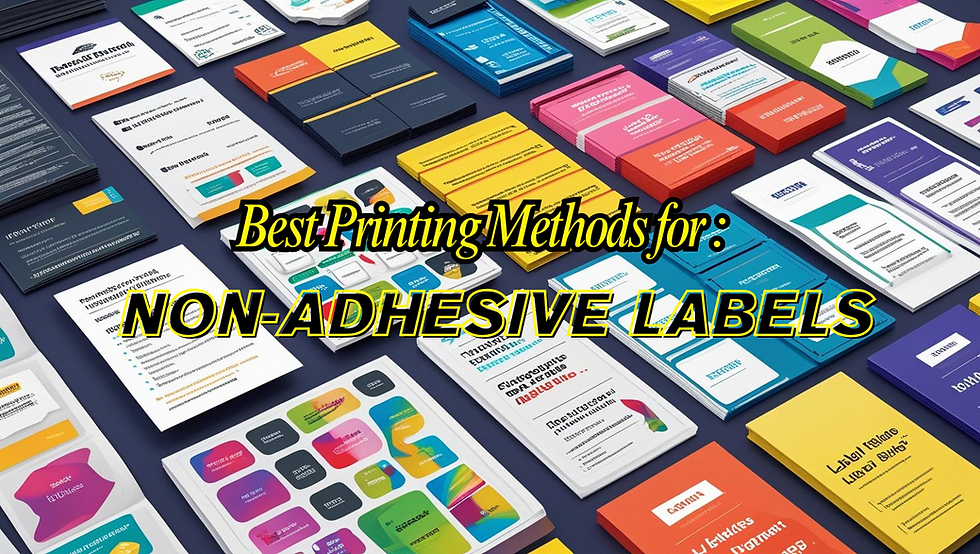Best Printing Methods for Non‑Adhesive Labels: Thermal, Flexographic, UV, and More
- Hongda Pack
- Jul 29
- 3 min read

Non‑adhesive labels are versatile for tagging, banding, hang tags, and wrap‑around identification, and choosing the right printing method is essential for clarity, durability, cost‑effectiveness, and environmental exposure. Here we explore the top printing options: thermal transfer, flexographic, UV, screen, digital, gravure, and specialty finishes.
Thermal Transfer Printing
Thermal transfer printing uses heat to melt wax, resin, or wax/resin ribbons onto a substrate like paper or polymer film. It's ideal for high-quality barcodes, QR codes, and asset tags requiring durability and resistance to heat, chemicals, humidity, and fading.
Advantages: durable, suitable for harsh environments, supports variable data, and works well with many materials.
Limitations: requires ribbons (higher consumable cost), slower than digital methods, and limited to monochrome or simple color options.
Flexographic Printing
Flexo is a high-speed rotary method using flexible relief plates to stamp ink onto wide-ranging materials, including paper, plastic films, and non‑woven substrates.
Advantages: economical for large runs, consistent color, compatible with water-based and UV inks, and handles custom substrates.
Limitations: higher setup cost and time, less fine detail compared to digital, and plate changes required for design updates.
UV Printing (Inkjet or Flexo)
UV printing uses inks cured instantly by ultraviolet light. Both flexographic UV and UV digital presses are supported by modern top-coated label stocks such as 3M Versatile Print Label Material 7875V, enabling high-quality, high-durability labels on heat-sensitive substrates
Advantages: immediate curing, vivid color, excellent adhesion to various materials, and compatibility with embossing or specialty inks.
Limitations: higher cost per label and sometimes drag under print heads which requires careful ink and substrate selection.
Screen Printing
Screen printing applies ink through mesh screens onto substrates like plastic, metal, or glass. It excels on curved or irregular surfaces and can produce embossed or layered effects.
Advantages: high opacity, excellent outdoor durability, allows decorative or textured effects, and mid‑volume quality.
Limitations: slower setup, costlier for variable or serialized data, lower resolution for fine detail.
Digital Printing (Inkjet or Laser)
Digital printing transfers designs directly from files without plates, using inkjet or laser technology. It's ideal for small batches, customization, variable information like QR codes and numbering.
Advantages: no plates, fast turnaround, high resolution, ideal for personalized or on-demand labels.
Limitations: less cost-effective at high volumes, may require specific top-coated substrates for best results, and some inks aren’t as water‑ or UV‑resistant as other methods.
Gravure, Offset, and Specialty Techniques
Gravure: engraving on cylinders yields premium clarity, vibrant color, and is suited for high-volume or luxury labels. Expensive setup means it's best for consistent high‑volume output.
Offset printing: transfers ink via metal plates onto a rubber blanket then onto substrate. It delivers sharp color quality and fine detail on paper-based materials, but is less commonly used for non-adhesive film labels.
Cold foil, hot stamping, spot UV, metallic effects: these embellishments add luxury appeal, metallic finishes, or fine detail effects, often integrated via flexo or foil stamping in addition to the primary printing process.
Comparative Overview
Printing Method | Best For | Pros | Cons |
Thermal Transfer | Durable, barcode and asset labels | Cost-effective for small runs; very durable | Ribbon cost; limited color |
Flexographic | Large volume, varied substrates | Fast, consistent color, low per-unit cost | Plate setup, less detail |
UV Flexo/Digital | Heat-sensitive substrates, high color density | Instant curing, vibrant color, durable | Higher cost, specialized substrate needed |
Digital Printing | Custom, short runs, variable data | Fast setup, personalization, high resolution | More expensive per label at volume |
Screen Printing | Textured, durable, decorative applications | Emboss, high opacity, curved surfaces | Slower; not suited to variable data |
Gravure / Offset | Premium quality, high-volume paper labels | Crisp color, fine detail | Expensive molds/plates, longer setup |
Foil & Specialty Effects | Luxury finishes | High visual impact | Typically adds cost and shape limitations |
Choosing the Right Method
When selecting a print method for non‑adhesive labels, key questions include:
What is the expected volume? Small runs favour digital or thermal; large runs favour flexo or gravure.
What are the environmental conditions? Tagging inside or outside? Exposure to weather, heat, abrasion?
Is customization or serialization needed? Digital or thermal transfer handles this best.
Are there decorative or specialty finishing needs? Consider foil stamping, spot UV, or screen printing effects.
Contact a reliable non‑adhesive label supplier to evaluate substrate options, testing, and method suitability based on your product needs.
Conclusion
Each printing method for non‑adhesive labels offers distinct trade‑offs: thermal transfer for durability and barcode use, flexographic for high volume, UV for vivid color and fast curing, digital for customization, screen for textured aesthetics, and gravure or offset for premium precision. The right choice hinges on volume, substrate, durability, environmental factors, and whether customization or embellishment is needed.
Work closely with a specialized provider like HongDa who understands these methods and helps align them to your brand’s specific requirements to ensure high‑quality, cost‑effective non‑adhesive labels.



Comments